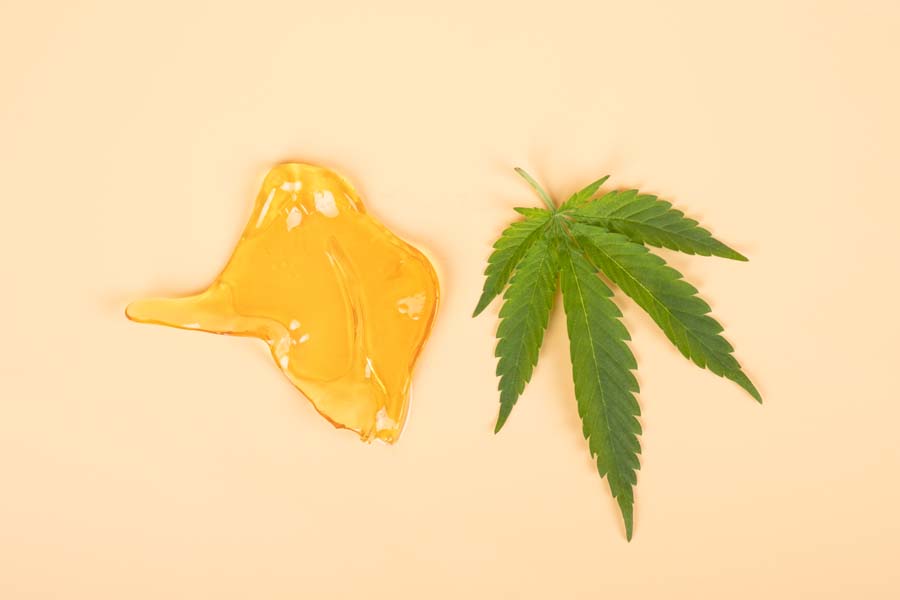Marijuana products come in many forms, from loose-leaf flowers to edibles to concentrates. If you’ve come across the term shatter and aren’t sure what it means or its uses, this article will provide all the details to ensure safety and precaution with it. Keep reading to get all the information.
What Is Shatter?
Shatter is a highly concentrated cannabis extract. Its appearance is solid and translucent, and it is referred to as “shatter” since it looks like it could shatter like glass. Its consistency is also very delicate, so it does tend to crack or shatter when broken apart, adding to the reason for the name.
However, unlike clear glass, shatter typically has a more gold or amber color. This coloration comes from the highly concentrated THC in it.
At a minimum, shatter contains at least 50% THC (the compound that makes you feel high when smoking or consuming marijuana). This dose is much higher than normal loose-leaf cannabis buds that contain 17-28% THC. Not to mention, on the high end, shatter can contain up to 95% THC.
Highly concentrated versions of shatter can make it more dangerous and addictive. Plus, most researchers say that high THC concentrates don’t provide any additional medical benefits compared to consuming traditional loose buds.
How Is Shatter Made?
Shatter is made by extracting THC and CBD cannabinoids from loose flower, bud, or trim. Heat is applied during production to facilitate this process and extract the desired cannabinoids.
The most common ways to create shatter involve using butane or hydrocarbon solvents. During this process, the plant material is tightly packed in a BHO extraction tube. Butane or other hydrocarbons are pushed through the tube to apply concentrated heat and strip out the cannabinoids, producing a concentrated oil.
After that, other techniques might be applied to purify the concentrate further.
One of those techniques is called “purging,” which involves removing excess solvents using a vacuum chamber.
Another method is “winterization,” in which the shatter is placed in a freezer. The colder temperature removes fats and liquids, often contributing to the shatter’s delicate, glass-like structure and appearance.
The Dangers of Making Shatter at Home
Some people attempt to make shatter at home. However, doing so is highly dangerous since the hot and intense butane flames can quickly get out of control. There have been several reports of house fires or explosions caused by people trying to perform DIY shatter production.
Instead, it’s better to leave production to professional manufacturers who have access to advanced closed-loop systems that contain the flames.
Uses of Shatter
Shatter is most commonly used when people are looking for a stronger high from cannabis. As mentioned earlier, there’s no research stating that consuming THC at these levels has medical benefits, so shatter is typically thought of as a recreational or party drug.
When taking shatter, it’s usually smoked and inhaled through a process called “dabbing.” This method involves using a dab rig with a water pipe and nail where you place the shatter. The nail with the shatter on it is heated by a torch, causing it to vaporize in the water pipe so it can be inhaled.
Others may also use vape pens, dab pens, or electric dab rigs to consume it. These electric rigs or vapes take a similar process to heat the shatter and turn it into vapor for inhalation.
Effects of Shatter

Since shatter is, on average, 2 to 4 times stronger than traditional loose-leaf cannabis, the effects someone feels from it are generally much more intense.
Here’s what initially happens in the body when someone smokes or vapes shatter:
- Within 30 seconds to 3 minutes: The THC travels from the lungs into the bloodstream.
- After 3 to 5 minutes: THC reaches the brain. It causes an initial release of dopamine, known as the happy hormone. However, after a few minutes, it also disrupts neurotransmitters, which are the brain’s messaging system for things like movement, memory, and judgment, so you might feel foggy or like things are processing slower.
- After 30 minutes to 1 hour: The body will begin feeling the full effects of the THC. Some people may experience an altered sense of time, impaired movement, difficulty problem-solving, and mood changes. These feelings last for about 1 to 3 hours before wearing off.
Since shatter is more potent, it’s common to experience more negative side effects in the short term. Some people might experience high levels of anxiety, delusions, hallucinations, or psychosis, which could lead to irrational or dangerous behavior.
Risks and Safety Considerations

Along with negative short-term effects, shatter can also have long-term health impacts, such as:
- Lung problems: Smoking shatter or other forms of marijuana does affect the lungs. Researchers have found a higher risk for lung cancer and other illnesses like lung infections or tuberculosis in those who smoke cannabis products regularly.
- Increased risk of heart complications: In the short term, shatter raises the heart rate for about 3 hours after use. This increases the risk of heart attack or complications in existing heart conditions. If someone experiences these effects, it could result in long-term health issues.
- Addiction: Cannabis doesn’t usually cause physical withdrawal symptoms. However, it can still cause a psychological dependence where someone feels like they can’t function normally when they aren’t taking it, or they might feel more anxious, depressed, or in a lower mood when they don’t consume it.
Safety Considerations with Shatter
Even though shatter and other cannabis products are legal for medical or recreational use in some areas, it’s still important to use precaution when taking them.
Just like consuming other substances like alcohol, moderation is important to maintain balance in your life and prevent addiction or dependence on it. Also, make sure you avoid driving after use since it will slow down cognitive processing, which could lead to serious accidents and injuries.
If someone experiences intense side effects after using shatter, like extreme anxiety or hallucinations, you should call 911 to get them immediate medical attention to make sure they’re safe.
In addition, if you notice yourself or someone you care about experiencing signs of addiction to marijuana, like trying to quit use and not being able to, neglecting responsibilities at work or school, or social withdrawal, make efforts to check in with them. Treatment centers can help with marijuana addiction to get back on track.
Legal Status and Regulation
Even if a state has legalized marijuana for medical or recreational use, that doesn’t mean that cannabis concentrates like shatter are available for legal purchase in those areas. Some states have limitations on how much THC products can contain when bought and sold legally. Regulations also can change, so check with your state’s laws and ensure you follow all current guidelines to avoid legal problems.
Conclusion
While shatter is a legal substance in many areas throughout the U.S., that doesn’t mean it’s without risks when using it. This highly concentrated form of cannabis can have serious side effects or lead to long-term negative health effects when used regularly. Therefore, you should always practice precaution.
If someone you care about is experiencing symptoms of addiction to shatter or other substances, our team at the United Recovery Project can help. Our team of medical professionals can create treatment programs tailored to your needs at our luxury treatment facility in Florida. Contact us today for more information.
References & Resources
- https://nida.nih.gov/publications/drugfacts/cannabis-marijuana
- https://cannabis.colorado.gov/responsible-use/safety-with-THC-concentrates
- https://nida.nih.gov/sites/default/files/teenbrochure_508.pdf
- https://www.getsmartaboutdrugs.gov/content/what-you-should-know-about-marijuana-concentrates-honey-butane-oil



